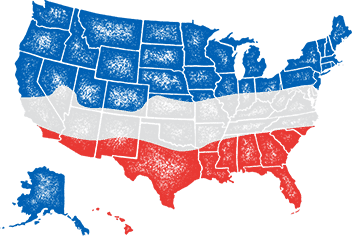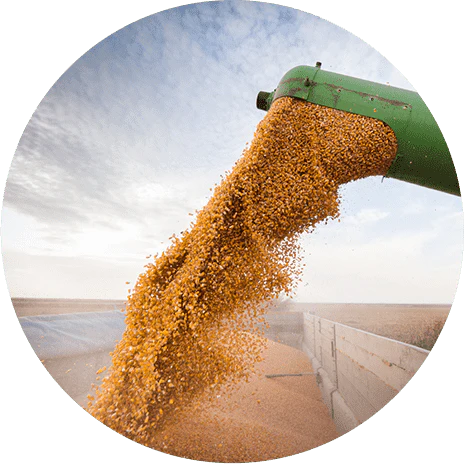
- When to plant:
- Spring, Fall
- Fertilizer:
- Varies
- Seeding rate:
- 75 - 100 lbs. per acre
- Seeding depth:
- 3/4 - 1 inch
- Ideal ph:
- 5.5 - 7.0
- Gmo:
- No
- Inoculant needed:
- No
- Coated or raw:
- Raw
- Lifecycle:
- Annual
- Climate zones:
- Transition Zone, Warm Season
Florida 501 Oats Seed is a great source of Fall and Winter forage for cattle, horses, goats, sheep, and food plots for deer. Oats are a nutritious and palatable forage, used for cattle feed stock, hay production, horses and dairy milk production.
Product Information
- Application or Use: Cattle Forage, Livestock Grazing, Cover Crop, Erosion Control, Hay Production, Food Plot
- Germination Time: 5 - 7 days, under optimal conditions
- Growing Locations: Warm Season & Transition Zone
- Height: 2 - 3 feet
- Sunlight Requirements: 8+ hours, full sun for best results
- Advantages: Nutritious and extremely palatable forage.
- When to Plant: Recommended planting time is fall and spring when night time temperatures are consistently below 65 degrees.
Oats planted for cattle forage are commonly planted with Winter Rye Grain, Winter Rye Grass and Rape, Turnip, Radish or Kale. Oats planted in food plots for deer and other wildlife can be planted with winter legumes such as Clover, Winter Peas and brassicas such as Radish, Rape, Turnip or Kale.
Florida 501 Oats are great for hay production, and should be planted in the early Fall for hay.
Florida 501 was released during 1968 by the North Florida Experimental Station in Quincy. This oat variety matures early and is best adapted to the Coastal Plains. It is resistant to Victoria blight, moderately resistant to soil-borne mosaic, and exhibits some tolerance to barley yellow dwarf virus. Florida 501 is susceptible to leaf blotch, prevalent races of crown rust and stem rust. In the absence of crown rust, Florida 501 gives high yields of good quality yellow grain. It is a good grazing oat with wide leaves and good tillering ability.
*Product packaging may appear different than what is pictured.
Florida 501 Oats are most successful when planted on well prepared soils with a pH of 5.5 or greater.
Plant at a rate of 75 - 100 lbs. / acre, at a depth between 1/2 in. and 1 in. Plant between Fall and Spring. Ensure that soil pH is between 5.5 and 7.0.
When planting Oats for hay plant 100 lbs. of seed per acre. Fertilizing will depend on the soil nutrients but typical applications are 350-500 lbs. per acre.
Oats can produce as many as 100 square bales per acre.
When choosing to start a new lawn, remove old vegetation by using a de-thatcher, power rake or tiller to kill the existing vegetation. Rake or drag the area to remove debris and dead grass for a clean area. Ensure the soil is leveled and loosened to allow the seed to have good soil contact once spread on a clean seed bed.
If you have an area with heavy weed coverage, we recommend starting fresh by killing and removing the existing vegetation. If you choose to use chemicals, herbicides or fertilizers, you must check with the product's manufacturer prior to planting new seed to ensure the proper waiting period.
When overseeding an existing area, mow your lawn at the lowest setting and bag the clippingsx. Rake or drag any areas that have dead thatch or debris.

Seed Quality
Hancock Seed is dedicated to delivering the best seeds possible to our customers. Hancock Seed grows and harvests many of our products, and we acquire the majority of the rest from other family farmers.
All these seeds are processed, packaged and shipped from Hancock Farm. This helps us ensure that our high standards are met. Unlike much of the competition, we refuse to sell you a seed that was not gathered during the last harvest. You will always receive fresh product from Hancock.
Every seed we grow comes with 40 years of experience behind it...you can rest assured that all of our products are cultivated in a method that assures its potential for growth.

Your cart ( 0 )

Florida 501 Oats Seed is a great source of Fall and Winter forage for cattle, horses, goats, sheep, and food plots for deer. Oats are a nutritious and palatable forage, used for cattle feed stock, hay production, horses and dairy milk production.
Product Information
- Application or Use: Cattle Forage, Livestock Grazing, Cover Crop, Erosion Control, Hay Production, Food Plot
- Germination Time: 5 - 7 days, under optimal conditions
- Growing Locations: Warm Season & Transition Zone
- Height: 2 - 3 feet
- Sunlight Requirements: 8+ hours, full sun for best results
- Advantages: Nutritious and extremely palatable forage.
- When to Plant: Recommended planting time is fall and spring when night time temperatures are consistently below 65 degrees.
Oats planted for cattle forage are commonly planted with Winter Rye Grain, Winter Rye Grass and Rape, Turnip, Radish or Kale. Oats planted in food plots for deer and other wildlife can be planted with winter legumes such as Clover, Winter Peas and brassicas such as Radish, Rape, Turnip or Kale.
Florida 501 Oats are great for hay production, and should be planted in the early Fall for hay.
Florida 501 was released during 1968 by the North Florida Experimental Station in Quincy. This oat variety matures early and is best adapted to the Coastal Plains. It is resistant to Victoria blight, moderately resistant to soil-borne mosaic, and exhibits some tolerance to barley yellow dwarf virus. Florida 501 is susceptible to leaf blotch, prevalent races of crown rust and stem rust. In the absence of crown rust, Florida 501 gives high yields of good quality yellow grain. It is a good grazing oat with wide leaves and good tillering ability.
*Product packaging may appear different than what is pictured.
Florida 501 Oats are most successful when planted on well prepared soils with a pH of 5.5 or greater.
Plant at a rate of 75 - 100 lbs. / acre, at a depth between 1/2 in. and 1 in. Plant between Fall and Spring. Ensure that soil pH is between 5.5 and 7.0.
When planting Oats for hay plant 100 lbs. of seed per acre. Fertilizing will depend on the soil nutrients but typical applications are 350-500 lbs. per acre.
Oats can produce as many as 100 square bales per acre.
Instructions
When choosing to start a new lawn, remove old vegetation by using a de-thatcher, power rake or tiller to kill the existing vegetation. Rake or drag the area to remove debris and dead grass for a clean area. Ensure the soil is leveled and loosened to allow the seed to have good soil contact once spread on a clean seed bed.
If you have an area with heavy weed coverage, we recommend starting fresh by killing and removing the existing vegetation. If you choose to use chemicals, herbicides or fertilizers, you must check with the product's manufacturer prior to planting new seed to ensure the proper waiting period.
When overseeding an existing area, mow your lawn at the lowest setting and bag the clippingsx. Rake or drag any areas that have dead thatch or debris.
















